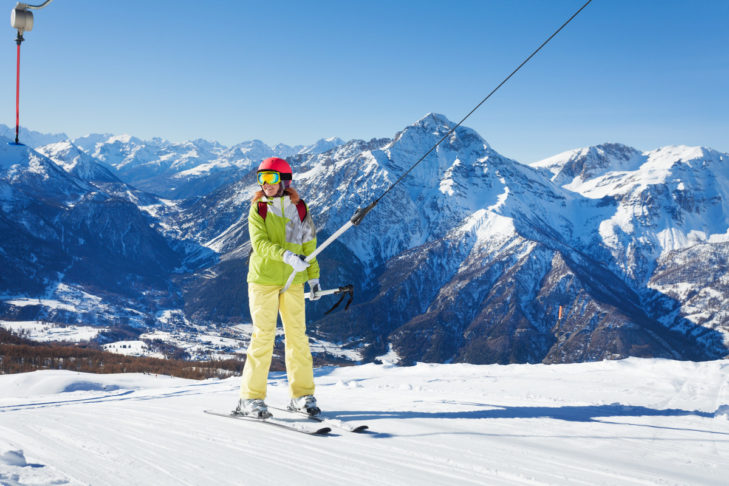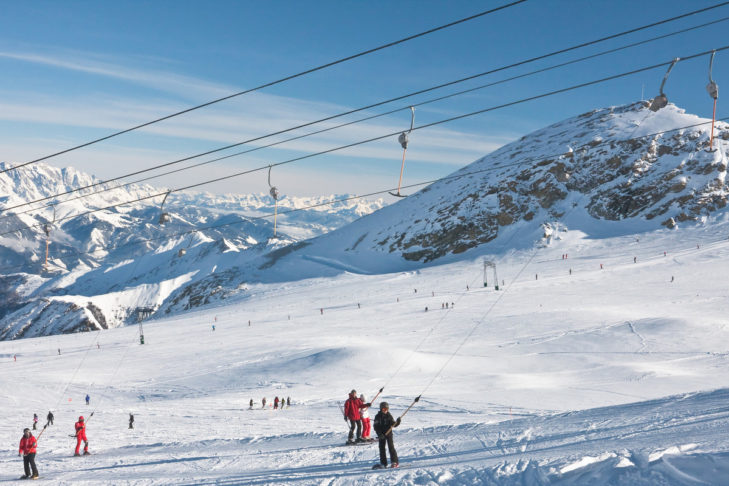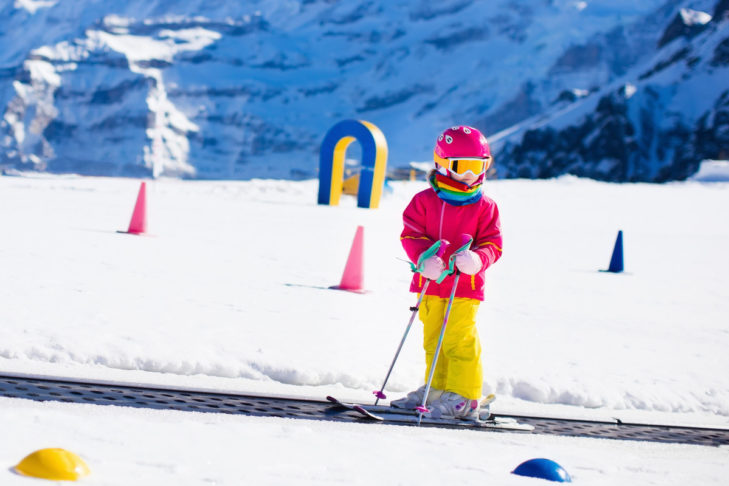When skiing was invented in the 17th century in the Slovenian town of Carniola, it didn’t need much: two wooden boards, a stick to navigate and a snow-covered slope. Even though a lot has happened to the equipment since then, it was mainly the modern ski lifts that made skiing suitable for the masses. But while many people think of comfortable and easy-to-use gondolas, there are other types of ski lifts, such as the chair lift or the drag lift, which pose a challenge for many beginners. Riding the drag lift often worries newcomers because the construction requires concentration and a good sense of balance on skis. Yet it is precisely the initial concerns about falling that throw inexperienced skiers off balance. But with some behaviour and a little practice, this can be quickly overcome and riding the drag lift will soon be child’s play.
The basics: from T-bar to button lift
Actually, all methods of transport for winter sports enthusiasts belong to the category of cable transport. The European Committee for Standardisation differentiates between various categories of so-called cable transport for passenger transport depending on the type of means of transport (rail or cable, for example), the type of operation or also the type of vehicles (gondola, chair lift, tow lift, etc.).
The drag lifts
With the drag lift, winter sports enthusiasts are pushed up the mountain with a mechanical bar construction. You ride in the open air and your feet are on the ground during the entire ride. There are two general types: drag lifts with a high rope guide and drag lifts with a low rope guide. A low rope guide means that skiers hold on directly to the rope or to an auxiliary construction. The high rope guide is equipped with stirrups or plate-round support surfaces. So instead of holding on to the rope, skiers take these for support. Drag lifts transport either one person or a maximum of two.
The button lifts
The button lift is sometimes called a baby lift, but this makes it sound easier than it is. Riding it actually requires a good sense of balance on skis. The button lift has a kind of round, platter-like plastic base at the bottom that you put between your legs. It is important not to sit completely on the plate, as it cannot support the weight of a person and otherwise you risk a fall. The button lift is only suitable for one rider.
The T-bars
The T-bars lift, on the other hand, has a double bar on which two people can sit side by side on the left and right. However, the skiers do not sit here either, they just lean against the bar with the backs of their thighs during the entire ride. The somewhat unusual, slightly angled posture is just a matter of getting used to it. In addition, the lifts usually run continuously without stopping. So you have to get in and out “on the move”. Even though this happens at a slow pace, it takes a little practice and skill to get in line. For beginners in particular, the first challenge is therefore often not skiing on the slopes at all, but being transported in the T-bar lift.
Riding the drag lift is very safe once you get the hang of it. You should only pay attention to a few basic things. Riders should follow certain rules during every phase of the ride in the drag lift.
The five phases of the lift ride
1. Queuing
On button lifts, queue one at a time and wait for your turn. Please do not push from behind or push in front of others waiting. Because the first skier’s rule already applies when queuing: show consideration, exercise caution. If possible, don’t leave any seats empty so that the skiers behind don’t have to wait longer.
At the T-bar lifts you usually wait in pairs. This means that each pair stands next to each other in a predetermined lane. If there is only one lane, it is important to agree in advance who will get on which side of the bar.
2. Boarding
As soon as entry is imminent, skiers take the ski poles in one hand. This leaves the other hand free to grab the handle and hold on. Until then, you should hold the poles in both hands as usual to help you move or brake. With the button lift it doesn’t matter which hand remains free, with the T-bar lift the poles go into the outer hand.
To be able to get on quickly and not hold up the operation, step into the lift line at the entry point. It is important not to leave your lane. The same applies to the anchor lifts. Here you enter the entry point from the left or right. Then all you have to do is watch carefully for the approaching drag lift.
As soon as the lift arrives, you turn inwards. Often there are staff who act as “boarding assistants” to help skiers grip the stirrups and align themselves. If you are experienced or the lift does not have a boarding assistant, you take the bar yourself. As a beginner, it can happen that you miss a bar or are not fast enough. In this case you should just stay calm and wait for the next one.
3. Approach
When approaching, it is important not to sit on the tow bar! Instead, lean slightly against the bar with the back of your thighs and let yourself be pushed. When starting up, the initial push can cause a short jolt. You should be prepared for this and compensate with your body and hold on tightly to avoid falling. Even if this is unfamiliar at first, you will soon get a feeling for this swing. It can also vary from lift to lift.
4. Ride
Both skis should be even during the ride. Leaning back and forth should be avoided in order to keep your balance better. Always keep the skis in the drag line. Please refrain from experiments such as slalom skiing during the ride. It is also important to ski carefully in case – which happens not so seldom – a lost glove or ski pole lies in the track. The motto here is to get out of the way in good time.
5. Exit
60% of ski lift accidents happen when getting off the lift. However, this is not due to the technology of the lifts, but mostly to the winter sports enthusiasts themselves. Many people get too hectic when getting off the lift, forget all the rules of conduct and then a fall is almost inevitable. The most important rule when getting off is actually quite simple: do not get off prematurely, but wait until you have reached the flat exit point at the summit.
Tip: Prepare for the exit in good time and make sure that your clothes or rucksack are not caught in the hanger.
To exit safely, slide out to the prescribed side without rushing and release the tow bar towards the direction of travel – don’t worry, there is plenty of time! On an T-bar lift, the less experienced of the two skiers should get off first: The skier with more experience holds on to the bar during this time and then gets off himself by pushing the bar away from him. Then leave the track quickly to make room for the next skier and also to avoid being hit by the next bar.
The right behaviour in unexpected situations
But what should be done if the lift stops or someone falls during the lift ride? The motto in unexpected situations is always: stay calm!
Riding a surface lift requires concentration. The ride can be jerky and wobbly, and because you are not really sitting down, you can lose your balance. Many falls happen directly on the approach because you get scared at the first “jerk” and let go of the bar or grab the bar too late. This can easily be avoided with a little calm. If you are too slow to use the bar safely, it is better to wait for the next one.
If you do fall, the most important thing is to clear the lift track as quickly as possible. Otherwise, successors will not be able to avoid you and you could injure yourself and others. To do this, it is best to crawl to the side if you cannot get up quickly. First make sure that you leave the track uninjured before collecting lost objects afterwards. If the person in front of you falls and cannot get out quickly enough, you can slide around them on your skis. Otherwise, let yourself fall to the side in time to avoid a major accident.
If your lift partner falls, you call out to each other to decide what to do next. The person who has fallen down lets his partner know whether you will also get out of the lift and ride down together from there, or whether he will continue his descent alone.
If the lift stops in the middle of the ride, you remain standing calmly. At best, do not wobble or stand up abruptly in the lift, but simply wait for the ride to continue or for the lift staff to give instructions. Even if the standstill takes longer and it is exhausting to hold the position: Please do not stand across the slope – because the lift can start up again at any time.
The same applies to unexpected jerks or curves. Some surface lifts make turns to avoid trees, rocks or other obstacles on the ground. If you are not attentive, you can easily lose your balance. To avoid this, pay attention to the route with a certain amount of foresight and steer along a bit.
In the drag lift with children or beginners
Beginners in particular often have difficulty getting on and off the lift quickly. Here it is helpful to know the rules of conduct well and not to panic. But most beginners quickly get the hang of it after a few rides in the drag lift and then ride just as safely as everyone else.
While adults are often worried before they ride the drag lift for the first time, children approach the matter more at ease. Nevertheless, it is important that they also know the rules of conduct and do not ride alone, especially the very first time. Before going on the lift, the size of the children should be clarified. Small children are not allowed to ride on some button lifts because they could slip under the bars too easily. Some lifts offer baby lifts or a so-called “magic carpet” as an alternative. This is a kind of conveyor belt at the bottom that pulls the little ones up while standing. When skiing together with children, it is practical if the child holds both ski poles in the outer hand from the beginning, while an adult holds the child by the other hand. Or you can also take the child’s poles in your own hand.
Tip: When getting on, the child should look towards the top and not, for example, in the direction of the handle, so that he or she is positioned directly correctly for getting on and remains there.
Children tend to sit down at the drag lift. It should be explained to them beforehand that the drag lift cannot carry them – so they could fall down more easily. Therefore, children are also only allowed to lean.
FAQs about the T-bar lift
What is a drag lift?
A drag lift is a mechanical lift for winter sports enthusiasts. In contrast to a chairlift, you stand upright during the ride. There are two types of drag: the button or plate lift for one person or the T-bar with a bar for up to two people.
What is the most common cause of accidents on drag lifts?
Drag lifts have been transporting winter sports enthusiasts safely up the mountains for almost 100 years. The greatest danger of accidents does not come from the lift, but from the people themselves. 60% of accidents occur due to carelessness when getting off the lift, another part when getting on. Attention and calmness can therefore prevent most accidents.
How does boarding work?
To get on, go to the boarding lane, take the ski poles in one hand (always in the outer hand in the case of the double bar), and let the boarding assistant support you or take hold of the bar yourself. Afterwards, you do not sit down, but lean against the bar with the back of your thighs.
How do I behave during the ride?
During the ride, you should remain calmly leaning against the bar and put equal weight on both skis. To avoid falling, do not turn or wobble.
What happens if I miss a bar?
Beginners in particular need to practise their coordination a little when entering the drag lift. If you miss a bar, it’s no big deal: just stay calm and take the next one.
What do I do if the drag lift suddenly stops?
Normally, a drag lift is constantly in motion. If the lift stops unexpectedly, winter sports enthusiasts should not get off independently, but remain standing until it continues or follow the instructions of the lift staff.
What happens in the event of a fall?
In the event of a fall, you should remain calm and move out of the lift line as quickly as possible to avoid accidents with people following you. If you cannot get up quickly enough, the easiest way is to crawl out to the side.
Can children also ride the drag lift?
Yes! Children should master the rules and practise coordinating when getting on and off. On certain models, the bars may be too high. In this case, children must be accompanied by adults or, if available, use a lower baby lift.
How does getting off work?
Getting off should be done quickly but without rushing. Before getting off, make sure that the clothes are not caught in the hanger and then get off to the side indicated. Let the hanger fall forward in the direction of travel. Important: Never get off prematurely during the ride.






